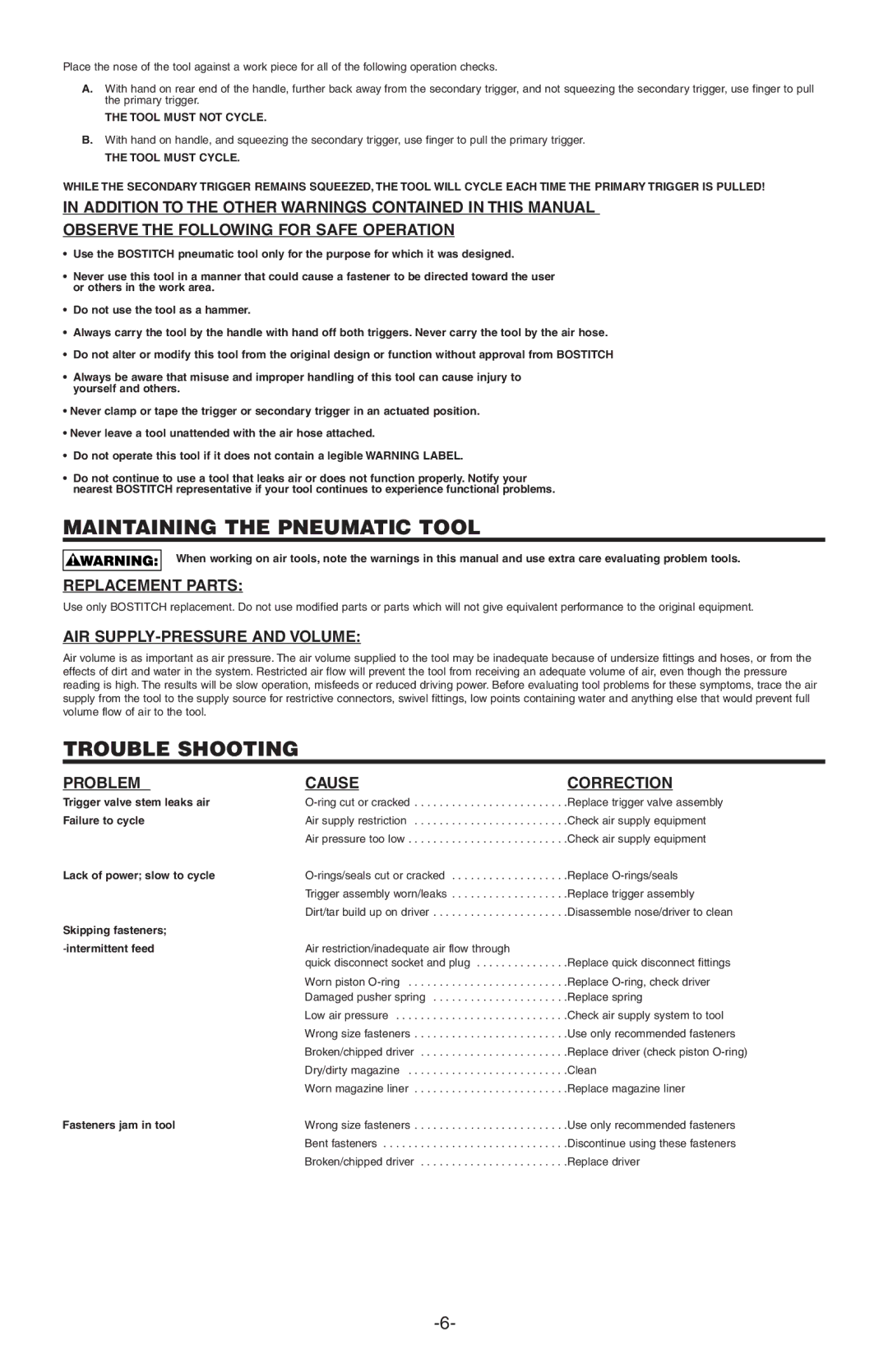
Place the nose of the tool against a work piece for all of the following operation checks.
A.With hand on rear end of the handle, further back away from the secondary trigger, and not squeezing the secondary trigger, use finger to pull the primary trigger.
THE TOOL MUST NOT CYCLE.
B.With hand on handle, and squeezing the secondary trigger, use finger to pull the primary trigger.
THE TOOL MUST CYCLE.
WHILE THE SECONDARY TRIGGER REMAINS SQUEEZED, THE TOOL WILL CYCLE EACH TIME THE PRIMARY TRIGGER IS PULLED!
IN ADDITION TO THE OTHER WARNINGS CONTAINED IN THIS MANUAL
OBSERVE THE FOLLOWING FOR SAFE OPERATION
•Use the BOSTITCH pneumatic tool only for the purpose for which it was designed.
•Never use this tool in a manner that could cause a fastener to be directed toward the user or others in the work area.
•Do not use the tool as a hammer.
•Always carry the tool by the handle with hand off both triggers. Never carry the tool by the air hose.
•Do not alter or modify this tool from the original design or function without approval from BOSTITCH
•Always be aware that misuse and improper handling of this tool can cause injury to yourself and others.
•Never clamp or tape the trigger or secondary trigger in an actuated position.
•Never leave a tool unattended with the air hose attached.
•Do not operate this tool if it does not contain a legible WARNING LABEL.
•Do not continue to use a tool that leaks air or does not function properly. Notify your nearest BOSTITCH representative if your tool continues to experience functional problems.
MAINTAINING THE PNEUMATIC TOOL
When working on air tools, note the warnings in this manual and use extra care evaluating problem tools.
REPLACEMENT PARTS:
Use only BOSTITCH replacement. Do not use modified parts or parts which will not give equivalent performance to the original equipment.
AIR SUPPLY-PRESSURE AND VOLUME:
Air volume is as important as air pressure. The air volume supplied to the tool may be inadequate because of undersize fittings and hoses, or from the effects of dirt and water in the system. Restricted air flow will prevent the tool from receiving an adequate volume of air, even though the pressure reading is high. The results will be slow operation, misfeeds or reduced driving power. Before evaluating tool problems for these symptoms, trace the air supply from the tool to the supply source for restrictive connectors, swivel fittings, low points containing water and anything else that would prevent full volume flow of air to the tool.
TROUBLE SHOOTING
PROBLEM | CAUSE | CORRECTION |
Trigger valve stem leaks air | .Replace trigger valve assembly | |
Failure to cycle | Air supply restriction | .Check air supply equipment |
| Air pressure too low | .Check air supply equipment |
Lack of power; slow to cycle | .Replace | |
| Trigger assembly worn/leaks | .Replace trigger assembly |
| Dirt/tar build up on driver | .Disassemble nose/driver to clean |
Skipping fasteners; |
|
|
| Air restriction/inadequate air flow through |
|
| quick disconnect socket and plug | .Replace quick disconnect fittings |
| Worn piston | .Replace |
| Damaged pusher spring | .Replace spring |
| Low air pressure | .Check air supply system to tool |
| Wrong size fasteners | .Use only recommended fasteners |
| Broken/chipped driver | .Replace driver (check piston |
| Dry/dirty magazine | .Clean |
| Worn magazine liner | .Replace magazine liner |
Fasteners jam in tool | Wrong size fasteners | .Use only recommended fasteners |
| Bent fasteners | .Discontinue using these fasteners |
| Broken/chipped driver | .Replace driver |
